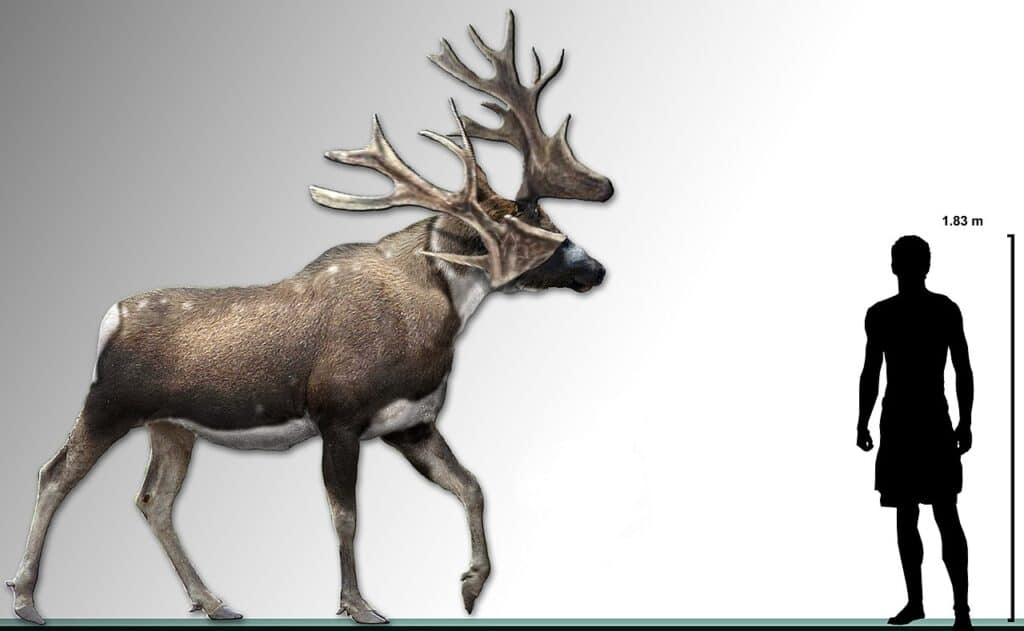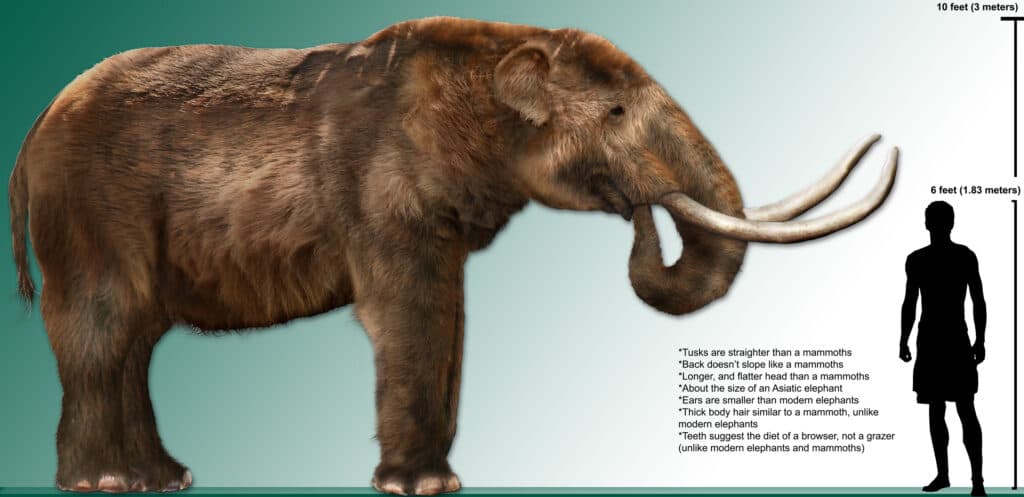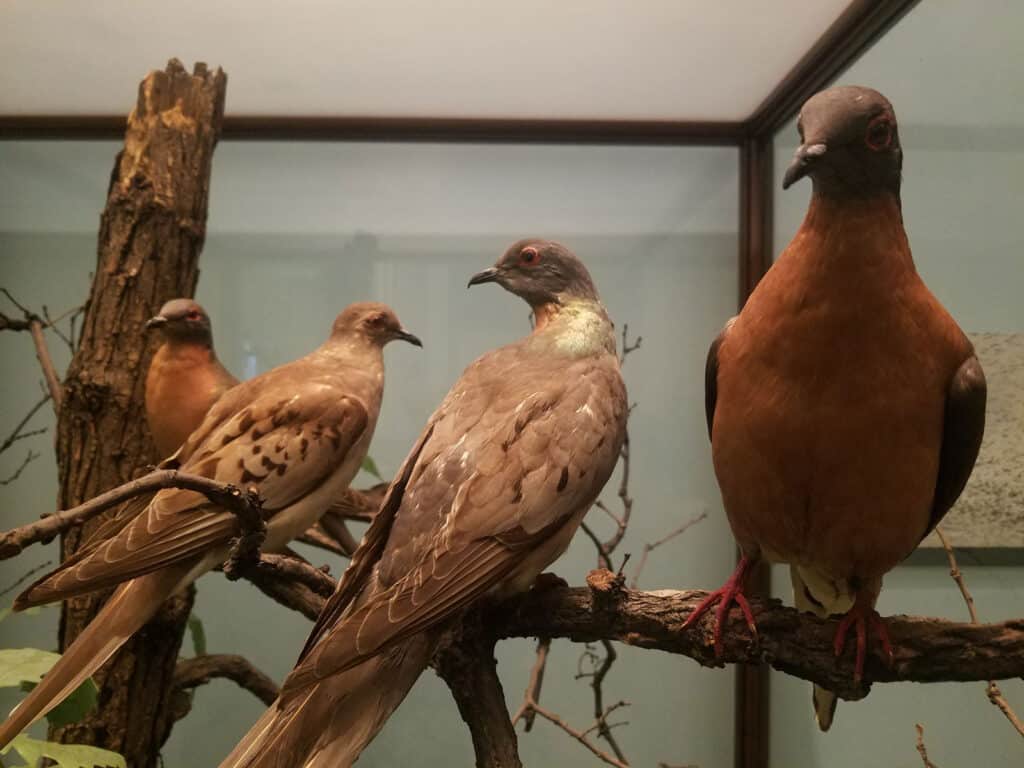Wildlife in Wisconsin thrives because this state has 34.8 million acres of abundant woodlands, beaches, hills, rivers, wetlands, waterfalls, and lakes. The state is also famous for its national parks. Wisconsin is the 23rd largest and the 21st most populous state in America.
The white-tailed deer is the official wildlife of Wisconsin, but did you know there were other extinct wildlife that lived in this state? The following are the six extinct animals that lived in Wisconsin.

1. Giant Jellyfish

The fossils of giant jellyfish in Wisconsin are the largest jellyfish in the entire fossil record.
©Dan Hershman / CC BY 2.0 – License
| Giant Jellyfish | |
|---|---|
| Kingdom | Animalia |
| Phylum | Cnidaria |
| Clade | Medusozoa |
| Class | Scyphozoa |
| Living Period | Cambrian Period – 500 million years ago |
In 2002, a fossil dealer named Dan Damrow unearthed extraordinary evidence of life during the Cambrian period. They discovered a jellyfish fossil in a quarry in Mosinee, Wisconsin, about 200 miles northwest of Milwaukee. According to the report, these jellyfish fossils were unlike any other modern jellyfish. The fossilized impressions of jellyfish were about 3 feet (91 cm) in diameter.
There are theories that these giant jellyfish lived 510 million years ago, were stranded, and then buried in a shallow lagoon. The fossils of giant jellyfish in Wisconsin are the largest jellyfish in the entire fossil record, which makes scientists believe that they were among the top predators during their time. We only know a little about their evolution, but further studies about the predatory lifestyles of the early Cambrian jellyfish imply they are pelagic, which means they live in the upper layers of the open sea.
There are many theories on how consciousness evolved. Many scientists believe the Cambrian period is the first geological period where the genetic origins of consciousness evolved.
2. Trilobites

Wisconsin is famous for its well-preserved fossils of trilobites.
©iStock.com/Aunt_Spray
| Trilobites | |
|---|---|
| Kingdom | Animalia |
| Phylum | Arthropoda |
| Class | Trilobita |
| Order | Phacopida |
| Species | Calymene celebra |
| Living Period | 521-252 million years ago |
Calymene Celebra were species of Trilobites from the Arthropoda phylum. These species were named the “dinosaur of anthropods.” They lived on the Earth during the Silurian period when the most remarkable biological event was happening: the earliest fishes were evolving. Wisconsin is famous for its well-preserved fossils of trilobites. In fact, trilobites are the state’s fossils.
3. Elk-moose (Cervalces)

Elk-moose can grow up to 98 inches (8.2 feet) in length and weigh 1,562 pounds.
©Dantheman9758 at English Wikipedia / CC BY 3.0 – License
| Elk-moose (Cervalces) | |
|---|---|
| Kingdom | Animalia |
| Phylum | Chordata |
| Class | Mammalia |
| Order | Artiodactyla |
| Family | Cervidae |
| Subfamily | Capreolinae |
| Genus | Cervalces |
| Species | Cervalces Scotti |
| Living Period | Late Pleistocene epoch – 2.5 million to 11,700 years ago |
Cervalces Scotti is an evolution of the broad-fronted moose that originated on the Eurasian continent. Thousands of years ago, during the Late Pleistocene epoch, this species of large moose roamed North America. They are commonly called stag-moose or elk-moose. Elk moose can grow up to 98 inches (8.2 feet) in length and weigh 1,562 pounds (708.5 kg). They are much bigger and heavier than the modern elk. The largest species of living elk are Roosevelt elks, and they only grow up to 60 inches (5 feet) tall and weigh 1,200 pounds (544 kg).
The fossils of the Cervalces Scotti were found at Kluck Farm, near Bevent, Marathon County, Wisconsin. Different species of Cervalces were also discovered in Michigan, Indiana, Ohio, Illinois, and Iowa.
One of the theories of their extinction is often attributed to human overkill. Coincidentally, the elk-moose and other mammals began disappearing when humans arrived. Their deaths can also be attributed to climate change. When the Earth shifted from a glacial to an interglacial climate, Earth became warmer, and large ice sheets melted.
4. Woolly Mammoths

The extinction of woolly mammoths was widely attributed to human overkill.
©Dotted Yeti/Shutterstock.com
| Woolly Mammoths | |
|---|---|
| Kingdom | Animalia |
| Phylum | Chordata |
| Class | Mammalia |
| Order | Proboscidea |
| Family | Elephantidae |
| Genus | Mammuthus |
| Species | Mammuthus Primigenius |
| Extinct since | Early Holocene – 11,000 years ago |
Woolly mammoths, scientifically named Mammuthus Primigenius, are one of the largest mammals that roamed North America during the Ice Age. They were so common in Wisconsin that we could find mammoth sites in the area. The Schaefer site, located in the Southeast of Wisconsin, has contributed many mammoth fossils that made us understand more about how these animals lived. They are herbivores often hunted by dire wolves, cave hyenas, and large cats. They survive and avoid their predators by traveling in herds.
The extinction of woolly mammoths was widely attributed to human overkill. Research in 2002 gave context to the demise of mammoths in Wisconsin. The remains of woolly mammoths found in southeastern Wisconsin were declared butchered. These human-modified remains suggested that the early humans used to hunt them for food.
5. Mastodon

The Mastodon americanum is the most common among several species of mastodon.
©CC BY 3.0 / Dantheman9758 – License
| Mastodon | |
|---|---|
| Kingdom | Animalia |
| Phylum | Chordata |
| Class | Mammalia |
| Order | Proboscidea |
| Family | Mammutidae |
| Genus | Mammut |
| Species | Mastodon americanum Mastodon cosoensis Mastodon matthewi Mastodon Pacificus Mastodon raki Frick |
| Extinct since | 11,000 years ago |
The Mastodon americanum is the most common among several species of Mastodon. Mastodons may look like mammoths, but they originated from a different genus. If you observe the critical distinction between the two, you will notice that mastodons have more prominent tusks.
According to research, early humans and Mastodons may have had a relationship. As several bones from different mastodons were found in the exact location, theories developed about the hunting habits of early humans. As their weapons advanced, they no longer hunted individual animals. Theories believed they started to hunt groups or herds of mammals.
6. Passenger Pigeon

Passenger pigeons used to be among the most abundant birds in the world.
©ChicagoPhotographer/Shutterstock.com
| Passenger Pigeon | |
|---|---|
| Kingdom | Animalia |
| Phylum | Chordata |
| Class | Aves |
| Order | Columbiformes |
| Family | Columbidae |
| Genus | Ectopistes |
| Species | Ectopistes migratorius |
| Common name | Wild Pigeon |
| Extinct since | 1914 |
Passenger pigeons, scientifically named Ectopistes migratorius, are aves from Columbidae family. Pigeons were often described as “rats with wings.” Because of this, some locals were worried that they were unclean. But little evidence supports the claim that they can transmit diseases like rats.
Passenger pigeons used to be one of the most abundant birds in the world. Their extinction was unique because of the rapid decline of their species. There are many studies about why they went extinct suddenly, but the leading causes were the commercialization of pigeon meat and the loss of their habitat. Some theories believe they may have been overwhelmed by a cyclonic disturbance while migrating, destroying their entire species in one blow. Climate change was reported to set traps for migratory birds. Their last migration was the big “nesting” in Michigan in 1878.
The photo featured at the top of this post is © Liliya Butenko/Shutterstock.com
Thank you for reading! Have some feedback for us? Contact the AZ Animals editorial team.






